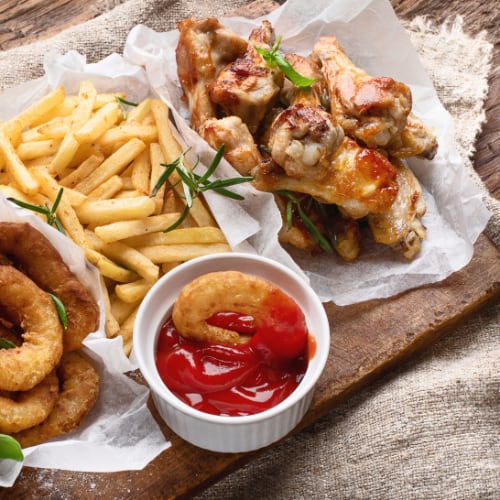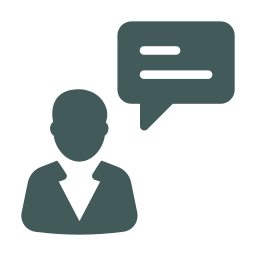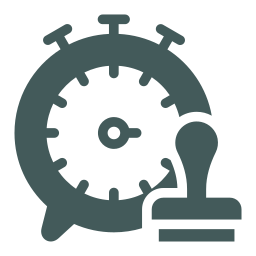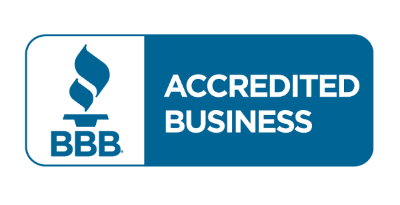
Overfed & Undernourished
Nutrition
Changing our eating habits is one of the most challenging parts of getting and staying fit, healthy, and happy. Many Americans struggle with unhealthy eating habits, regularly indulging in processed, fast, and convenient foods. However, no matter how much we eat, we are not getting the nourishment we need from these foods.

Overfed & Undernourished
Nutrition
Changing our eating habits is one of the most challenging parts of getting and staying fit, healthy, and happy. Many Americans struggle with unhealthy eating habits, regularly indulging in processed, fast, and convenient foods. However, no matter how much we eat, we are not getting the nourishment we need from these foods.
Minimizing Unhealthy Eating Habits
Anyone reading is likely familiar with the feeling of wanting to live a healthier lifestyle but struggling to figure out a way to do this that is realistic and effective. Often the struggle to eat healthier winds up in hours of debate with ourselves before we settle on more take-out and promise to eat healthier tomorrow. However, eating more whole natural foods, and less processed foods, is essential to leading a happier and healthier lifestyle.
This article covers the impact our harmful eating habits have on our health and productivity and how to curb the problem sooner rather than later.
How are My Eating Habits Impacting My Health?
Many of us already know that what we eat impacts our health. However, when most people think of how unhealthy foods harm our bodies, their mind jumps to unhealthy weight gain. Unhealthy food habits go beyond this impact and can affect your health in ways you may not have considered.
Beyond weight gain, an unhealthy diet with poor nutrition can lead to heart disease, stroke, type 2 diabetes, and cancer. The Centers for Disease Control and Prevention (CDC) discovered numerous troubling facts about the impact of a lack of nutritious food on the population. The CDC found:
- 9 in 10 Americans over-consume sodium, with over 70% of sodium intake coming from packaged and processed foods
- 1 in 6 pregnant women has low iron levels, causing potential issues during pregnancy
- Nearly $173 billion per year is spent on healthcare to treat obesity-related illnesses
- 42% of adults are obese
Unhealthy eating habits also harm our productivity. You aren't alone if you've ever felt sleepy, lazy, and drained after a meal or snack. Larger quantities of unhealthy foods like candy, chips, desserts, bread, pasta, processed foods, baked goods, sugary sodas, and caffeinated beverages cause you to feel lazy and unmotivated, making it more difficult to get things done.
How Can I Make the Change?
Recognizing unhealthy foods in your diet and deciding to eat healthier is easier said than done. How often have you spent the day eating healthier foods, only to reach for the junk foods at nighttime? For many people, the constant back and forth between healthy and unhealthy habits make it difficult to stick to a regimen.
Determining how we can practically change our foods and make a difference in our health might seem harder than it is-at least once you know what you're doing and how to stick to your plan.
There are two important things to identify when you decide to make a significant change in your diet: what foods to avoid and what foods to implement into your diet. Those that don't make necessary changes in their eating habits are more likely to struggle in numerous ways. Cleveland Clinic health experts found the following to be true:
- Over two-thirds of heart disease-related deaths involve food choices and habits. An estimated 6 million deaths may have been avoidable with improved dietary choices.
- Healthy lifestyle choices reduce your risk of stroke by 80%, and diet is currently the most significant health issue in the United States.
- Poor dietary patterns contributed to nearly half of 700,000 deaths in a 2017 report. The deaths included heart disease, stroke, and type 2 diabetes.
As you can see, whether or not we change our eating habits has a massive influence on our lifestyle. When we eat healthier foods, we can minimize the damage caused to our health because of a lack of nutrition.
What Foods to Avoid
To start changing your eating habits and living a healthier lifestyle, focus on some of the following foods and begin to gradually phase them out of your diet. Individuals who consume these foods regularly are more likely to suffer from the ailments listed previously. Start with the following foods:
- Foods with excessive amounts of sodium
- Sugary beverages
- Processed meats
- Foods high in saturated fats
- Fast foods like burgers, pizza, or fries
- Alcohol, especially in large quantities
- Specific sources of animal fat, including cheese, full-fat milk, and red meat
What Foods to Enjoy
If the previous list made you worry about what foods you could enjoy, fear no more-there are plenty of delicious, healthy foods you can enjoy guilt-free. Some of the best foods to start incorporating into your diet might include:
- Fruits, especially berries
- Eggs prepared soft boiled
- Chicken breasts
- Nuts and seeds like almonds, coconuts, and chia seeds
- Vegetables, particularly dark green vegetables such as broccoli and spinach
- Salmon
- Shellfish
- Shrimp
- Green beans
- Sweet potatoes
- Dark chocolate
As you can tell, there are many delicious foods you don't have to worry about when sitting in bed at night or tired at work from late-night snacks. Investing in a healthier lifestyle isn't as complicated as we think it is, and when you know what healthy foods you like, building a diet around them is easy.
The Bottom Line
While transitioning to a healthier diet may seem daunting, it is less complicated than you may think. Healthier eating will not only help you avoid obesity-it changes every aspect of your health, from lowering your risk of chronic disease to helping you be more productive and fulfilled in all of the things you choose to do.
If you're ready to eat healthier but don't know where to start, try our free, online healthy living whole-foods recipes. This online cookbook allows you to search for easy-to-make meal recipes that use only whole natural foods.

Jay Todtenbier is an original founder of SupplementRelief.com in 2010 and has operated the business ever since. He is also a tennis instructor and gospel musician. Formerly he spent 25 years in business development, technology and marketing with startups and major corporations having gone through the tech boom in Silicon Valley in the 90s. He became passionate about, and began studying and practicing Wellness as a Lifestyle after experiencing chronic, personal health challenges including depression, auto-immune disorders, and being overweight that impacted his ability to live a healthy, vibrant life. Since then, he has been an advocate for healthier living encouraging others to live better through making small, gradual changes to lifestyle behaviors relating to whole-foods nutrition, stress management, reasonable exercise, proper sleep, and the use of targeted, high-quality supplements.
Learn more about Jay Todtenbier.
-
 Discussion Forum
Questions or Feedback?
Discussion Forum
Questions or Feedback?Ask questions. Share your thoughts. Note that we cannot answer questions relating to specific medical conditions - please refer those to your qualified healthcare provider.
Post a new Comment or Reply to an existing one. Help for using the Discussion Forum.
 Discussion Forum Help
Discussion Forum Help
Comments are displayed in order of the last one posted so the most recent one is at the top and the oldest one at the bottom.
Replies within a Comment are displayed in reverse order with the oldest one at the top and the most recent one at the bottom.
Each post identifies
 who made the post and the
who made the post and the  date and time the post was made.
date and time the post was made.Mouse over the icons for tooltips that explain what they mean.

If you see this icon you can attach an Audio file to your post.

If you see this icon you can attach a Document file to your post.

If you see this icon you can attach an Image file to your post.

If you see this icon you can attach a Video file to your post.
You will see the
 Ban icon (Report Post as SPAM) immediately following the Timestamp of the post. Click this icon if you feel strongly that the content posted is not appropriate and should be reviewed by the Forum Moderator. You will be provided with a confirmation dialog to be sure you wish to submit this post for review. If submitted, the Forum Moderator will be notified to review the post and will determine what type of action to take.
Ban icon (Report Post as SPAM) immediately following the Timestamp of the post. Click this icon if you feel strongly that the content posted is not appropriate and should be reviewed by the Forum Moderator. You will be provided with a confirmation dialog to be sure you wish to submit this post for review. If submitted, the Forum Moderator will be notified to review the post and will determine what type of action to take.Click
 in the upper right corner of this Help modal or anywhere on the web page outside of the modal to exit Help.
in the upper right corner of this Help modal or anywhere on the web page outside of the modal to exit Help.
![]() Session Expired from Inactivity
Session Expired from Inactivity
Do you want to?
9618 Jefferson Highway, Suite D-191
Baton Rouge LA 70809-9636
(888) 424-0032 |
support@supplementrelief.com
* Disclaimer: This page is available exclusively for SupplementRelief.com clients. None of the information on this website is intended to replace your relationship with your healthcare provider(s). Nothing should be considered medical advice. The information, knowledge, and experience shared on this website are the opinions of SupplementRelief.com. This site and its content are intended to enhance your knowledge base as YOU MAKE YOUR OWN HEALTHCARE DECISIONS in partnership with your qualified health professional.
* These statements have not been evaluated by the Food and Drug Administration. These products and services are not intended to diagnose, treat, cure, or prevent disease.
* There is NO GUARANTEE OF SPECIFIC RESULTS for the products or services offered, and the RESULTS CAN VARY for each individual. Any results claimed by our customers are based on individual experiences that are unique and cannot be guaranteed.
FirstFitness Nutrition and NuMedica may be promoted and sold on the internet ONLY by Authorized Resellers who have been approved by and have registered their website domain with these companies. They strictly prohibit, and actively monitor, the UNAUTHORIZED SALE or RESALE of their products in ALL online public shopping portals including Amazon, eBay, and others and into other countries. All products purchased in SupplementRelief.com are for PERSONAL USE ONLY and CANNOT BE RESOLD to others. Please report violations of Reseller Policy directly to FirstFitness Nutrition at 800.621.4348 and to NuMedica at 800.869.8100.
The content and photographs on this website are copyrighted or Licensed Material and may not be downloaded for other than personal use. Republication, retransmission, reproduction, or any other use of the content or photographs is prohibited. ©2010-2024 SupplementRelief.com.
Are you sure you want to remove this item?

